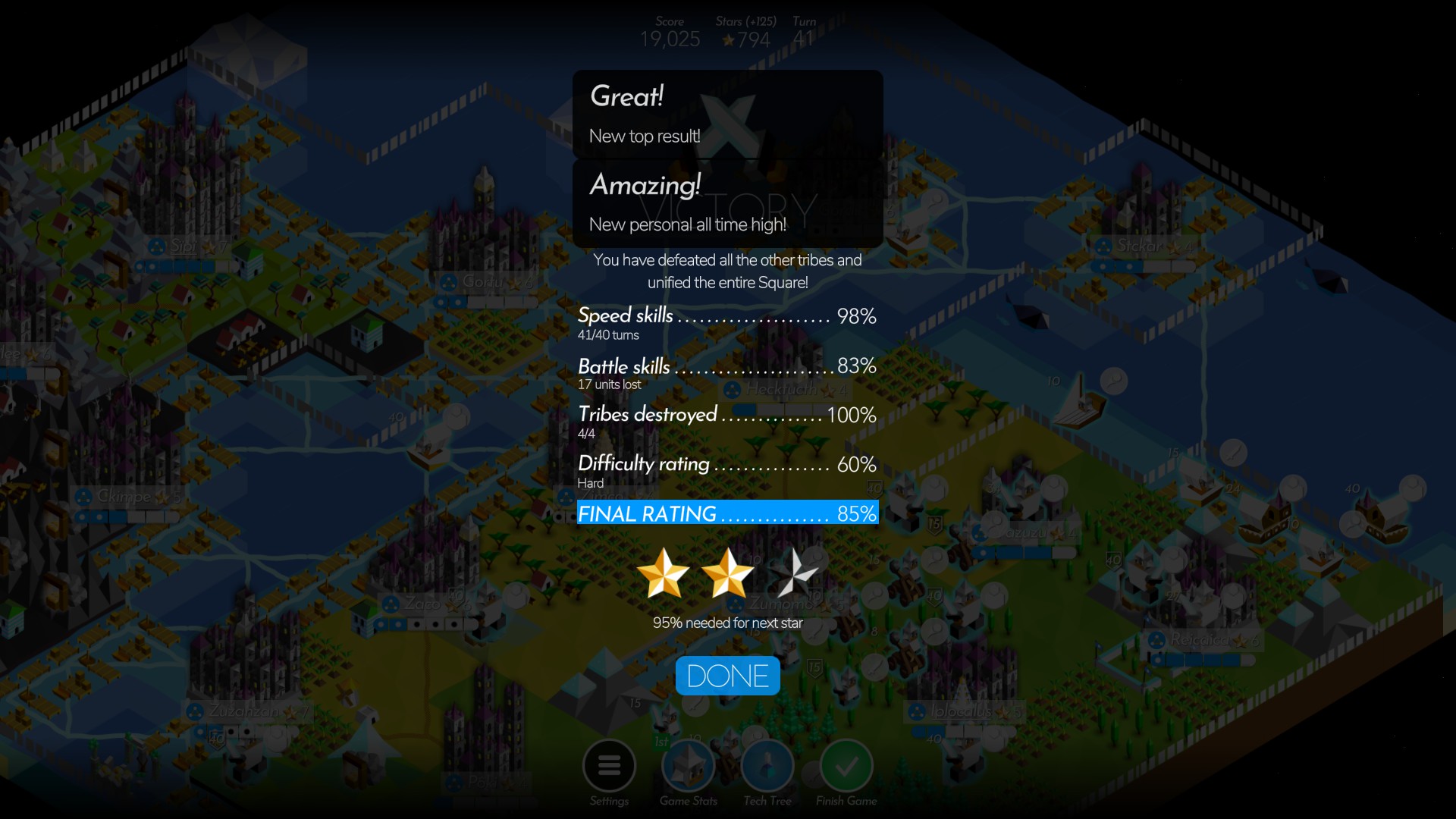The 4X experience in 30min or less
Type: Singleplayer, Multiplayer
Genre: Strategy, 4X
Developer: Midjiwan AB
Publisher: Midjiwan AB
Release date: 4 Aug, 2020
Cymanti Tribe DLC review


4X games are known for being deep, complex and time consuming. Even the Civilization series, which is on the more approachable side of the spectrum can be quite daunting for someone who’s not played a lot of strategy games. And sometimes even genre veterans might not have the time or energy to sit down and learn a new 4X game.
The Battle of Polytopia is the exact opposite of this. It’s a simple 4X game that removes most of the complexity that’s so often associated with the genre and boils it down to the very basics, and as a result you have a 4X game that can be beaten in 30min and that’s friendly to newcomers, without being shallow. It also removes any real pretenses of representing history and instead the tribes mostly fight because that’s what you do in a 4X game.
Presentation
With a name like The Battle of Polytopia the art style should be pretty obvious. It has a bright and colorful low-poly art style with big blocky models that does not make any attempts at looking realistic. Everything is heavily stylized, including the cities, terrain and any units. While simple, the art style in Polytopia is consistent through the game and nothing really looks out of place.
All the different civilizations, or tribes as they’re known here, have their own unique look with their own variants on units. Units that are still the same between the different tribes, though they look different. The cavalry from one tribe rides on larger birds, another rides on horses, and a third ride some kind of purple monster. With 12 different tribes that’s a lot of different units. And much like the tribes vary a lot in looks, so does the terrain. Different terrain have different variants on the same features, like fruit and creatures you can hunt. It all makes for a pretty good looking game. The only major drawback with how the game looks is that it’s not entirely obvious what a resource is the first time you see it. Fruits and animals are easy enough to tell apart, but farmable land and forests are not necessarily quite so obvious, at least if you’re only seeing one of the two the first time you encounter a new biome.
The sound design is sparse. All the 12 tribes have their own little jingle that plays when you select them, that for the most part roughly fits in with their real world inspirations, but once in game there’s no music on the main map screen. Other things still make sounds, like fighting, clicking on things and so on, and the sound that plays when you’re able to grow the population of your cities at once is quite satisfying, but the lack of music can make the game feel a bit empty at times.

Gameplay
All the fundamentals of a 4X game are here, you need to eXplore a randomly generated map, eXpand your empire, eXploit the local resources and eXterminate your neighbours. The difference is that where it usually takes a few hours before you’re really feeling in control in a 4X game and you understand all the important systems, in Polytopia it takes less than 30min.
As is customary for the genre after picking your civilziation, or tribe you get thrown onto a randomly generated map with a single city, and need to expand outwards from there. Expansion really is the name of the game, you’re not meant to sit back and build up your one city. Every turn you get a certain number of resources, depending on the size of your empire, and these are used for building improvements near your cities, researching new technology and training new military units. Doing things is simple, if you click on a piece of terrain you get a radial menu with all the things you can build, click on a city and you get a similar menu with all the units you can build and if you click on a unit you’ll see markers on the ground showing where you can move. Then you just click on the thing you want to do and it happens instantly.
Exploration is as easy as moving a unit to the edge of the area that you’ve explored. Once you reach the edge of it the squares surrounding your unit will be revealed. And if you’re lucky there will be what looks like a few huts huddled together on one of those revealed squares. These are the spots where you can build new cities. Colonization is done by letting a unit, any unit, end its turn on one of those spots and then at the start of the next turn you can create a new city.

City management is equally simple. Surrounding each city is a number of tiles, initially 8 but the city border can be expanded as the city grows. On a good portion of the tiles there’s some kind of feature, be it land fit for farming, forests, shallow water and so on, though there are also some tiles that are just flat. If you have the right tech you can exploit these tiles and as soon as you do you usually get some more population for your city. Once a city has reached a certain threshold you’ll get a choice between two different effects, like a super scout that instantly moves out and reveals a lot of land or permanent production bonus, city walls or a one-time influx of resources and so on.
Once you run into another tribe, which is likely to happen within a few turns after starting, the fighting can start. You have access to a bunch of different units, depending on what tech you’ve researched, and they all have something that makes the special. Cavalry can make a second move after having attacked, archers can attack from range, knights can attack again as long as it keeps killing things and so on. And then there’s the super units, which you can make once a city has grown big enough, these are just slow moving but really strong units with nothing special about them apart from their brute strength. These are what’s best suited for leading the charge and soaking up damage, but they’re not invulnerable, and you can’t make new ones at will. Conquering cities does by the way work similarly to colonizing, move into an enemy city and then at the start of the next turn, as long as your unit is still alive, you can take over the city.

Research is another simple thing. There’s a tech tree and you spend resources unlocking new tech. Tech unlocks instantly as soon as you pay for them and each piece of tech tends to give access to one to three things, like a new unit, the ability to move across mountains or a new building type that you can build around the city. Every tribe starts with one tech unlocked, and this is really the only thing that sets them apart, other than the way they look.
There are two different victory conditions, score or conquest and you chose one when setting up the game. With the score victory you’re simply trying to get the highest score possible in 30 turns. Almost everything gives some points, like exploring, taking over new land, growing your cities and the goal is simply to have a higher top score at the end of the game than anyone else. The other victory condition is conquest, where the game ends when there’s only one tribe left, who will of course be the winner.

Closing Thoughts
I’ve played 4X games since Civilization 2 and I’ve never played something quite like this before. Polytopia takes what’s always been a rather complex type of games and makes it approachable and really easy to get into. Though this simplification does come at a bit of a cost, it does not have the depth or longevity of games like Civlization, Master of Orion or Endless Legend. Particularly not in Singleplayer. But not every 4X game needs to be like the giants of the genre, and Polytopia manages to be refreshingly different. It might not be a game you’ll sink 50 hours into, but it’s worth at least a couple of hours.










